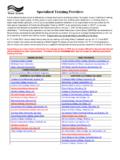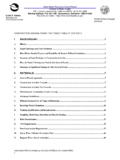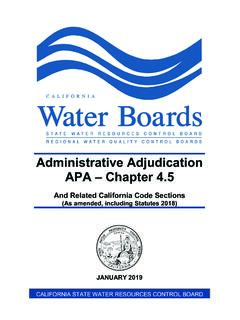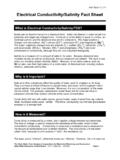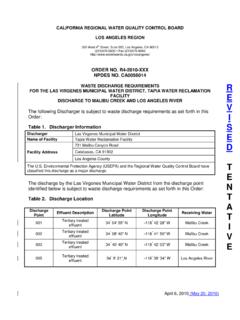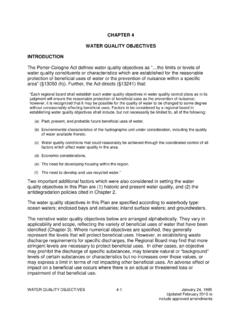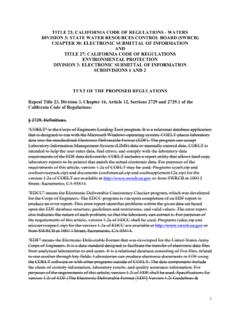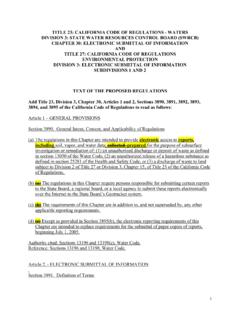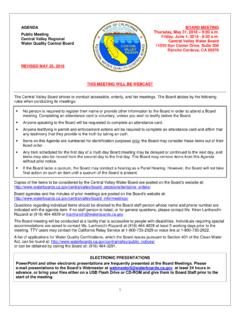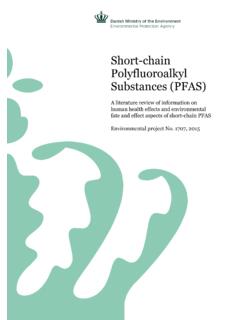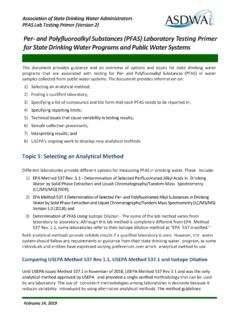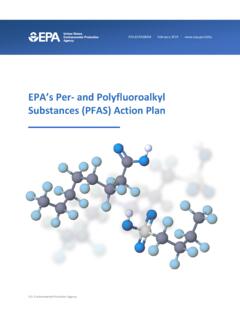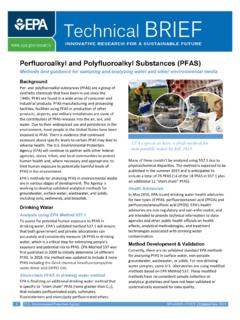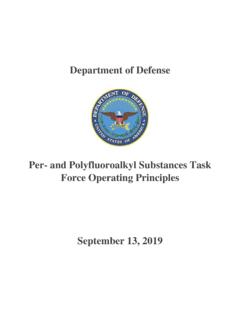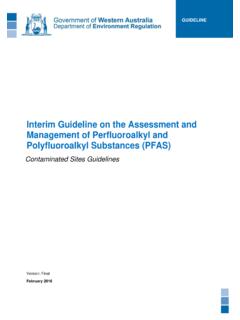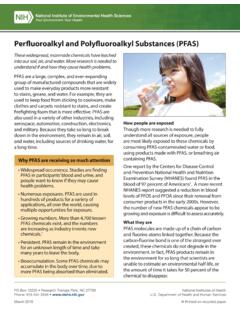Transcription of Per- and Polyfluoroalkyl Substances (PFAS) Sampling …
1 2019. Per- and Polyfluoroalkyl Substances (PFAS). Sampling Guidelines CALIFORNIA STATE WATER QUALITY CONTROL BOARD. DIVISION OF WATER QUALITY. March 20, 2019. TABLE OF CONTENTS. Introduction .. 2. General Sampling Guidelines .. 3. Personal Protective Equipment and Field Clothing .. 3. Sun and Biological Protection .. 4. Food Packaging .. 5. Sampling Procedures .. 6. Sampling Equipment .. 6. Sampling Collection and Storage .. 6. Decontamination .. 7. Field Quality Control Samples .. 8. References .. 9. 1 March 20, 2019. INTRODUCTION. Per- and Polyfluoroalkyl Substances (PFAS) are a class of manufactured compounds that are extensively used to make everyday items more resistant to stains, grease, and water. These chemicals have been used in a variety of industrial, commercial, and consumer products.
2 Some of these products could be present and/or used during a routine Sampling event, such as plastic bags and bottles, waterproof clothing, detergents, and waterproof pens and paper. The use of these products could possibly contaminate the samples during sample collection (including preparing the Sampling site, actual sample collection, decontamination, and shipment). The probability of false positives is relatively high during PFAS sample collection due to the potential for many sources of cross-contamination, combined with low laboratory detection limits (nanograms per liter, ng/L; or parts per trillion, ppt), and as such, care must be taken in the design and implementation of a PFAS Sampling program. This guidance will provide steps to take to help you avoid potential sample contamination.
3 2 March 20, 2019. GENERAL Sampling GUIDELINES. Before conducting any PFAS Sampling , it is recommended that a project-specific Quality Assurance Project Plan (QAPP) be developed. The QAPP should include the 24 elements identified by EPA guidance that describe the project's goals, data needs and assessment, responsible individuals, quality assurance plan, quality control measures, and reporting deadlines. The QAPP elements ( , analyte list, method of analysis, environmental matrices, and reporting limits) are based on the project objectives. The QAPP should clearly identify potential cross-contamination sources. These can include water used during drilling or decontamination, materials used within the Sampling environment, Sampling equipment, field clothing and personal protective equipment (PPE), sun and biological protection products, food packaging, and the environment itself.
4 Additional guidelines for the preparation of a QAPP can be found in the Water Boards QAPP. Development Resources website ( ) and Environmental Protection Agency's (EPA) Guidance for Quality Assurance Project Plans, EPA QA/G-5. (dated December 2002) and also located here: assurance-project-plans-epa-qag-5. Sampling materials and field supplies for the purposes of Sampling for PFAS are divided into three groups: 1. Allowable materials: These materials are proven not to be sources of PFAS cross contamination and can be used during all Sampling stages in the immediate Sampling environment. 2. Staging area-only materials: These materials may contain PFAS and should not come into direct contact with the sample but can be used in the staging area away from sample bottles and equipment.
5 Care should be taken to thoroughly wash hands and don new gloves after handling any of these materials. 3. Prohibited materials: These include items that are well-documented to contain PFAS and may present a threat to the integrity of the sample. PERSONAL PROTECTIVE EQUIPMENT AND FIELD CLOTHING. Any field planning and mobilization effort should address the physical, chemical, and biological hazards associated with each PFAS site. The mitigation of potential risks should be documented in a site-specific health and safety plan (HASP). The HASP should identify personal protective equipment (PPE) that is free of PFAS materials to avoid cross-contamination. PFAS are used to coat various clothing and leather products to repel water, oil, and dirt.
6 While preparing for Sampling , attention should be paid on clothing that is advertised as having waterproof, water-repellant, or dirt and/or stain resistant characteristics. These types of clothing are most likely to have had PFAS used in their manufacturing. 3 March 20, 2019. Allowable materials Staging area materials Prohibited materials Well-laundered synthetic or If the HASP requires a specific Water/stain/dirt-resistant 100% cotton clothing (with type of boot (such as steel- treated clothes (including but most recent launderings not toed), and PFAS-free cannot not limited to Gore-TexTM, using fabric softeners) be purchased, PFAS- free ScotchgardTM, RUCO , etc.). Powderless nitrile gloves over-boots may be worn. The New unwashed clothing Waterproof clothing made of over-boots must be put on, Clothes recently washed with or with polyurethane, PVC, and hands washed after fabric softeners wax-coated fabrics, rubber, donning the over-boots Clothes chemically treated neoprene before the beginning of for insect resistance and Boots made of polyurethane Sampling activities.
7 Over- ultraviolet protection and/or PVC boots may only be removed Coated Tyvek . in the staging area and after Latex gloves the Sampling activities are completed. Application of approved sunscreens and insect repellants (see below). There are many often-used and industry standard PPE items that may be required to be used during Sampling events that have not been completely evaluated, including hard hats, safety glasses, and Tyvek . If use of these items is required, they should be screened by reviewing the safety data sheets (if available) and/or collecting an equipment blank prior to use. SUN AND BIOLOGICAL PROTECTION. Because biological hazards (sunburn, mosquitos, ticks, etc.) may be encountered during Sampling , the elimination of specific clothing materials or PPE (sunscreens and insect repellants) could pose a health and safety hazard to staff.
8 The safety of staff should not be compromised by fear of PFAS-containing materials without any scientific basis. Personal safety is paramount. Any deviation from this guidance, including those necessary to ensure the health and safety of field staff, should be recorded in field notes and discussed in the final report. Prolonged sun exposure will require sunscreens, which may include PFAS in their manufacture. Protection against insects may require the use of insect repellant. The words natural and/or organic . in a product name or used to describe it does not mean that it is PFAS-free. Below is a detailed list of sunscreens and insect repellants that have been analyzed and found to be PFAS-free. Note that this is not a comprehensive list of allowable insect repellants or sunscreens; other products may meet the 4 March 20, 2019.
9 Requirements for use. Listing or omission of any product does not imply endorsement or disapproval. Also, there is no guarantee that these products will always remain PFAS free. Allowable Insect Repellants: o OFF Deep Woods o Sawyer Permethrin o Jason Natural Quit Bugging Me o Repel Lemon Eucalyptus Insect repellant o Herbal Armor o California Baby Natural Bug Spray Allowable Sunscreens: o Banana Boat Sport Performance Sunscreen Lotion Broad Spectrum SPF 30. o Meijer Sunscreen Lotion Broad Spectrum SPF 30. o Neutrogena Ultra-Sheer Dry-Touch Sunscreen Broad Spectrum SPF 30. o Banana Boat for Men Triple Defense Continuous Spray Sunscreen SPF 30. o Banana Boat Sport Performance Coolzone Broad Spectrum SPF 30. o Banana Boat Sport Performance Sunscreen Lotion Broad Spectrum SPF 30.
10 O Banana Boat Sport Performance Sunscreen Stick SPF 50. o Coppertone Sunscreen Lotion Ultra Guard Broad Spectrum SPF 50. o Coppertone Sport High-Performance AccuSpray Sunscreen SPF 30. o Coppertone Sunscreen Stick Kids SPF 55 L'Or al Silky Sheer Face Lotion 50+. o Meijer Clear Zinc Sunscreen Lotion Broad Spectrum SPF 15, 30 and 50. o Meijer Wet Skin Kids Sunscreen Continuous Spray Broad Spectrum SPF 70. o Neutrogena Beach Defense Water + Sun Barrier Lotion SPF 70. o Neutrogena Beach Defense Water + Sun Barrier Spray Broad Spectrum SPF 30. o Neutrogena Pure & Free Baby Sunscreen Broad Spectrum SPF 60+. If none of the above sunscreens or insect repellents are available, an equipment blank sample must be collected to verify that it is PFAS-free.
